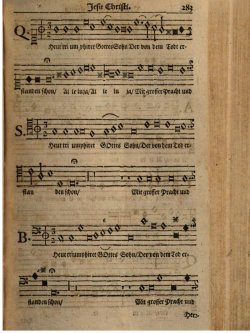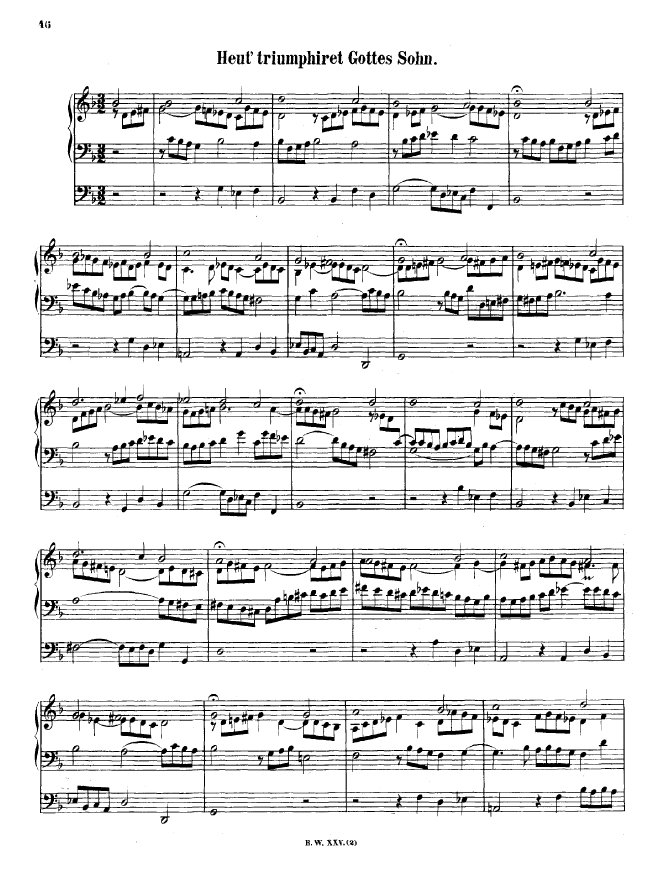|
Chorale Melodies used in Bach's Vocal Works
Heut triumphieret Gottes Sohn |
|
Melody & Text | Use of the CM by Bach | Use of the CM by other composers |
| |
|
Melody & Text: |
|
The Easter hymn, “Heut’ triumphiret Gottes Sohn,” appeared first in the Kinderspiegel (Eisleben, 1591) of Kaspar Stolzhagen, Lutheran pastor at Iglau, in Moravia. Whether he wrote it cannot be stated positively. It is also attributed to Jakob Ebert and Basilius Förtsch.
The melody (supra) is found in association with the hymn in Bartholomäus Gesius’ Geistliche_deutsche Lieder, published in 1601 at Frankfort a. Oder, where B. Gesius at that time was Cantor. The tune appears in 1601 for the first time and certainly was composed by B. Gesius himself.
Bach uses the melody in the Organ movement infra (BWV 630), Choralgesänge, No. 171 (BWV 342), but employs different melodic texts. In the Choralgesange the fourth and last phrases of the tune do not follow the original. In the Organ movement, excepting the last three bars, which are an added “Alleluya,” he follows the 1601 text and Witt, who also (No. 145) has three concluding “Alleluyas”
Charles Sanford Terry: Johann Sebastian Bach, Bach’s Chorals, vol. 3 The Hymns and Hymn Melodies of the Organ Works [1921], pp 183-185 |
|
Speculation regarding liturgical occasion: Häfner and Dürr suggest that this setting probably originated from the lost Picander–Jahrgang cantata Ich bin ein Pilgrim auf der Welt composed for Easter Monday, using the 3rd verse of Heut triumphieret Gottes Sohn. (NBA III/2.2 KB, p.186) This suggestion is further supported by the setting’s position (Chorale #18) in the Levy-Mendelssohn Collection (NBA Source D), portions of which are organized by liturgical occasion - Chorale 16 is from the St. John Passion (BWV 245), Chorale 17 is likely from the lost St. Mark Passion (BWV 247), Chorale 19 is, according to Häfner, from the Easter Day cantata in the Picander–Jahrgang, and Chorale 20 is from the Easter Tuesday cantata, BWV 145.
Source: bach-chorales.com (Luke Dahn, 2018) |
|
Melody: Zahn 2585
Composer: Bartholomäus Gesius (1601) |
 |
|
Text: Heut triumphieret Gottes Sohn (NLGB 95; GH 145; EKG 83; EG 109; KGEL 107)
Author: Kaspar Stolzhagen (1591); also attributed to Jakob Ebert and Basilius Förtsch |
|
Hymnal versions Bach may have known: |
|




|
|
Melody & text of Heut’ triumphiret Gottes Sohn (NLGB 95) from the Neu Leipziger Gesangbuch, pp 282-285 |
|


|
|
Melody & stanza 1 text of Heut’ triumphiret Gottes Sohn (GH 145) from the Gotha Hymnal, pp 78-79 |
| |
| |
|
Use of the Chorale Melody by Bach: |
|
Text: Heut triumphieret Gottes Sohn |
|
Chorale Heut triumphieret Gottes Sohn, BWV 342
Ref: RE 79; Br 79; KE 171; Birnstiel 70; AmB 46II p.150; Levy–Mendelssohn 18; Fasch p.39; BGA 89; BC F95.1; CST 175 |
 |
|
Untexted: |
|
Chorale Prelude Heut triumphieret Gottes Sohn (I), BWV 630 |
|
Chorale Prelude Heut triumphieret Gottes Sohn (II), BWV 630a |
|
The movement is the last of the Easter Preludes in the Orgelbüchlein, instinct with the triumph of the festival. The Pedal subject, as Schweitzer points out, is almost ferocious in its representation of the risen Christ spurning his foes as though He were treading the wine-press. In Cantata BWV 43, written for Ascension Day (1735), the Aria “ ’Tis He Who all alone hath trodden well the wine-press” has a similar masterful subject3. |

 |
| |
| |
|
Use of the Chorale Melody by other composers: |
| |
| |
|
Sources: Bach Digital; BGA; Zahn; BCML discussions on BCW; Charles Sanford Terry's Bach Chorals books
Photos from Gottfried Vopelius: Neu Leipziger Gesangbuch (Vopelius 1682) & Christian Friedrich Witt: Psalmodia Sacra, Oder: Andächtige und schöne Gesänge… (Gotha Hymnal, 1715), were taken from digital copies of the books downloaded from Bayerische Staatsbibliothek München. These copies are Out of copyright - non commercial re-use (Europeana Rights).
Prepared by Aryeh Oron (October 2018) |